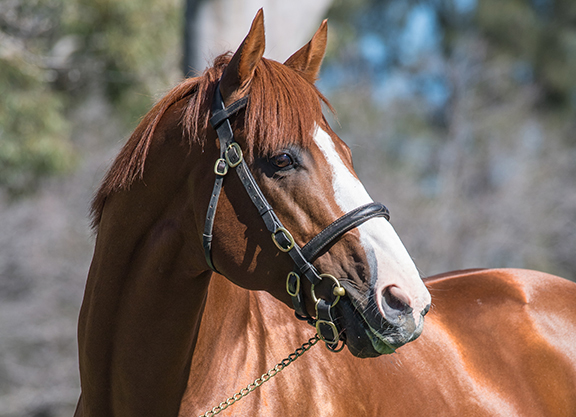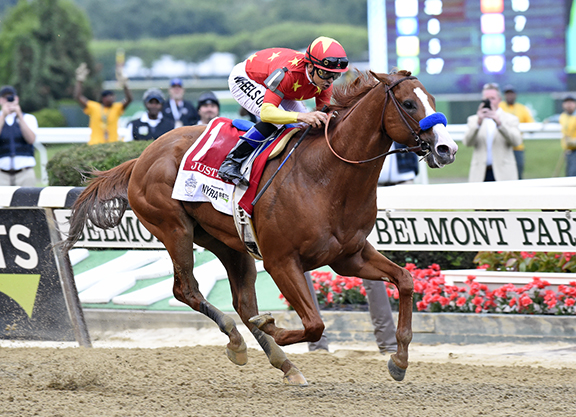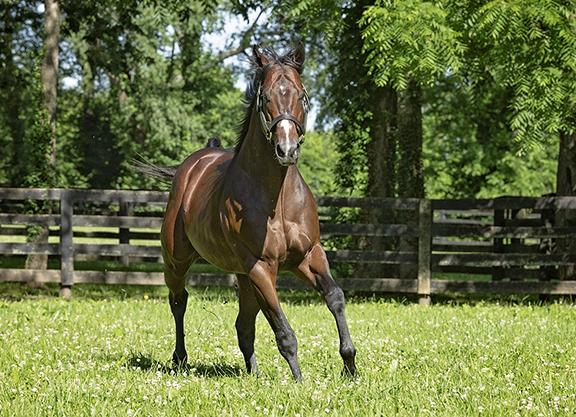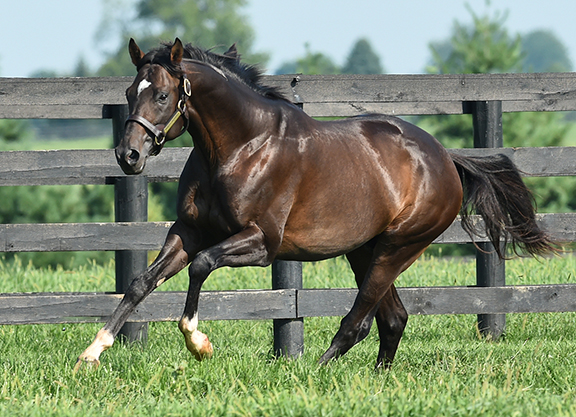By Chris McGrath
As we all know, the more a stallion has to prove, the more the market indulges him. As each intake shows more of its hand, however, breeders become progressively more nervous of young sires disproving judgements that are themselves typically more concerned with the anticipation of demand at the sales, than of any potency they may (or may not) be able to recycle on the track.
In this third instalment of our survey, then, we begin our descent of the slippery slope with the first group to offer a hint of what they might actually be made of, having in recent weeks offered their first weanlings to market.
Quite how reliably that market will judge this early stock is another matter. Because year after year, it's the same: almost invariably, the average prices paid for first weanlings tend pretty scrupulously to reflect their ranking by covering fees.
A couple of years ago, for instance, the top six rookies by fee in Kentucky duly filled the top six weanling averages among their intake–and more or less in sequence, too. The only one who elevated himself conspicuously higher than his fee rank was Runhappy.
The year before, conversely, the outlier had been a big disappointment: Constitution. While the other pair who had launched at $25,000, Liam's Map and Carpe Diem, respectively averaged $131,281 and $110,475, Constitution managed only $65,895. (In offering 37 foals, moreover, he had sent much the biggest sample of his work into the ring.)
In other words, let's be careful about reading too much into the market verdict on these first weanlings. Had you treated the few variations from fee rankings as any kind of weathervane, you might well have expected Constitution to be on his way to Turkey by now. That's what happened to Daredevil, after all, having finished just behind him in the averages (off half the fee). And we know what happened to Daredevil next. No need, by the same token, for anyone to give up on Runhappy despite his underwhelming first juveniles.
If their rare departures from the values initially presented by the farms prove to be so misplaced, little wonder purchasers end up adhering pretty slavishly to the pecking order implied in the cost of conception. In future, however, they might as well keep out of the November sleet, and not bother hauling themselves from barn to barn to inspect these living, breathing animals!
With that in mind, we should draw limited inferences from the “performance” at the weanling sales of those stallions who will be presenting their first yearlings to market in 2021. For the record, a couple who failed to hold their place in the weanling averages, relative to fees, were West Coast and Always Dreaming. But they remain absolutely entitled to maintain a resemblance to Constitution once their stock actually gets onto the racetrack in 2022.
In the meantime, of course, this group stands nervously before a commercial highwire: their 2021 covers will go to the yearling sales in 2023, when their first crop will be showing their prowess or otherwise on the track as sophomores. If you back one that lands running, you'll hope to be in clover. But the rest will be exposed to a precipitate decline in the value of their brand.
That won't disqualify them from breeding runners, however. And with so many farms cutting fees across the roster, to keep the carousel turning in the pandemic economy, there should be some excellent value around. Overall, it's an attractive group with interest at most levels.
The top of the weanling averages, unsurprisingly in the context we have just established, was JUSTIFY (Scat Daddy–Stage Magic, by Ghostzapper). The only Triple Crown winner to remain unbeaten in the history of the American Turf bestrode the intake with an opening fee of $150,000, and Ashford got him going last year with an unbelievable first book of 252 mares–matched, nationally, only by another rookie by the same sire, starting at the same farm, in Mendelssohn. Justify received another 222 guests this time round, and gets a clip to $125,000 to negotiate the approaching “bubble.”
With 474 covers in his first two years, presumably all mares deserving of the fee, Justify will need to do precisely as his name suggests with his first crops. As always, there's a witting trade-off in the sheer volume of traffic. On the one hand, he will surely find runners to keep his name in lights, however his percentages stack up against rivals with smaller books. At the same time, good luck if you're going to rely on kudos to get any duds through the sales: there won't be a lack of alternatives. Of the 16 weanlings who put their heads over the parapet, nine reached their reserves; but vendors were understandably prepared to try again if not satisfied (RNAs up to $400,000) while those that did sell achieved a very decent yield at $421,737.
So while it's always a long way down, at numbers like this, Justify should be equal to the challenge if the basic tenets of our industry hold up. Performance we scarcely need to reprise. Physique is barely less extraordinary. He exudes such virility in the flesh that you feel intimidated just standing near him, and the Storm Cat line can seldom have yielded such a vivid example of its trademark power and musculature. And pedigree is cogent enough: first three dams all at least graded stakes performers; likewise, his tragic half-brother.
The keystone of his family tree, as has been explored many times, is the duplication in its fourth generation of sisters Preach and Yarn: Justify's second dam is by the former's son, Pulpit, while his grandsire Johannesburg is out of the latter's daughter Myth (Ogygian). The sisters' dam Narrate, moreover, was by Honest Pleasure–whose brother For The Moment is sire of Justify's fourth dam; while their sire Mr. Prospector is also Scat Daddy's damsire. That Mr. P. bedrock gets a perfect foil in the Classic quality and stamina of Nijinsky, who also recurs top and bottom, including (but not only) as Narrate's damsire. How gratifying it was, to see such thoughtful breeding repaid by historic achievement; and fortunate is the breeder who can afford to tap into it now.
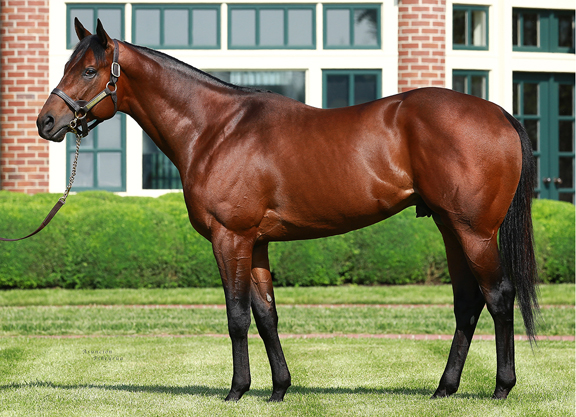
City of Light | Lane's End
Among the mortals, the highest opening fee was charged by CITY OF LIGHT (Quality Road–Paris Notion, by Dehere), who was initially offered at $35,000 and elevated to $40,000 after rounding off his resumé with a six-length romp (and 112 Beyer) in the GI Pegasus World Cup. And he could hardly have made a better debut at the sales, selling a dozen of 14 weanlings for a knockout average of $216,000–behind only Justify; more than double any other stallion in the intake; and at an unrivalled yield.
This shouldn't have surprised anyone. Of the three recruits made by Lane's End in this intake, we'll all have had our individual favorites. I did think Accelerate (Lookin At Lucky) was particularly good value, priced as he was, but City of Light is a most seductive animal and also looked worth every cent of his fee. A lot of breeders evidently agreed, as he has managed to hold his fee in the teeth of the economic gale, doubtless aided by the exemplary management of his books by a farm that tries to keep a premium on the brand by not flooding the marketplace. Many others would cheerfully have kept the door revolving long after City of Light reached 146 mares in both his first two seasons.
In terms of sheer class, he looks a valid alternative–and not just a more accessible one–to his $150,000 sire. From his breakout success in the GI Malibu S., City of Light proved invincible except in two very pardonable circumstances, stretching his speed just too far over 10 furlongs and given the slip by the dashing Whitmore (Pleasantly Perfect) after a three-month layoff. His performance in the GI Dirt Mile, breaking his pursuers with a blazing 110 Beyer, was one of the most charismatic of recent Breeders' Cups. That was one of four Grade Is won by City of Light, though his GII Oaklawn H. defeat of Accelerate (the rest beaten off 10 lengths) differed only formally in caliber.
He is, moreover, a thing of beauty ($710,000 Keeneland September yearling); and his dam is a three-parts sister to a Grade I winner out of a Grade I winner. Even without that level of quality, I would already love two first dams by distaff influences as resonant as Dehere and Somethingfabulous. (The latter's mother Somethingroyal actually holds the whole pedigree together: her great son, Secretariat, is damsire of Dehere; while Quality Road's sire Elusive Quality draws together Secretariat and Sir Ivor, a grandson of Somethingroyal, as damsires of his sire and dam respectively.) Though City of Light's own forte was plainly dirt speed, there are interesting shades of green under the third dam, who produced a top-class European colt of his era in Cacoethes (Alydar), so his brilliance might well prove transferable to any theater.
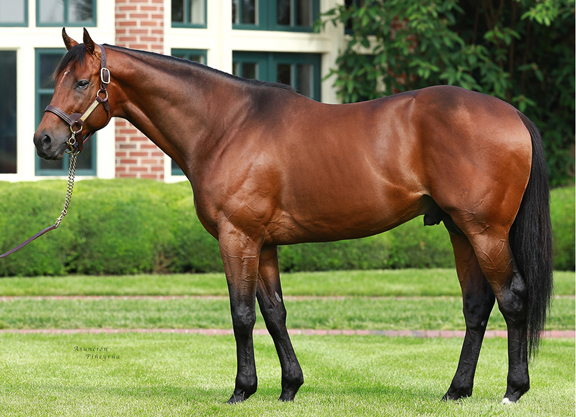
West Coast | Lane's End
Many others, surveying the Lane's End trio, preferred to pin their colors to the mast of WEST COAST (Flatter–Caressing, by Honour and Glory). True, he has not started quite so smoothly: his second book diminished from 168 to 103, and his fee from $35,000 to $20,000 after obtaining an ordinary average ($64,764) with his first weanlings. As we keep saying, however, the only true measure of these horses still remains some way down the road and West Coast still has every chance.
He is out of a champion juvenile filly who has produced a couple of other graded stakes performers, and his physique sustained a $425,000 yearling tag (highly respectable for his sire). Having sat out the Classics, he bloomed in time to pick up the pieces in the GI Travers and sealed the sophomore title when first of the crop home behind Gun Runner (Candy Ride {Arg}) and Collected (City Zip) in the GI Breeders' Cup Classic. And at four he raked in some of the biggest place purses around, taking his career earnings past $5 million.
It's not necessarily the most decorated pedigree past the dam, but it has a couple of interesting knots. Both his sire and dam are out of granddaughters of Raise a Native, respectively via Mr. Prospector and Majestic Prince–whose own family ties back into the bottom line: West Coast's fourth dam is by My Host, a full-brother to the second dam of Majestic Prince (as well as to Kelso's sire Your Host). Mares who bring Real Quiet or Pleasant Colony into play might tighten this strand in interesting fashion.
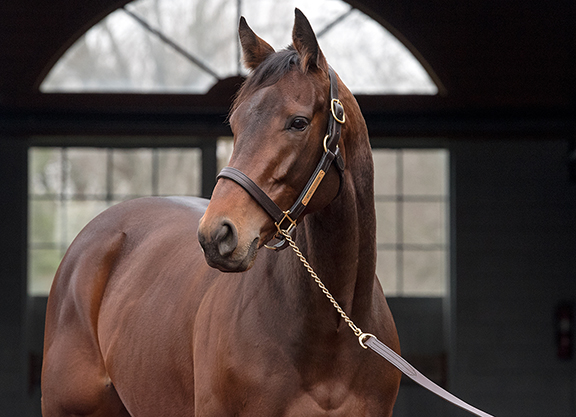
Mendelssohn | Sarah Andrew
As we've already noted, MENDELSSOHN (Scat Daddy–Leslie's Lady, by Tricky Creek), matched his illustrious new neighbor at Ashford in herding an eye-watering 252 mares for his debut season. Remarkably, a second book of 242 was surpassed only by Uncle Mo and Into Mischief and he duly holds his fee at $35,000 after a solid debut at the sales, processing as many as 19 of 23 offered at an average $95,736.
Clearly, you're not going to be short of options if you want a Mendelssohn yearling in 2021 or 2022. That said, it would be disappointing if the other side of this gamble–that he will produce an early star or two to keep him going–should fail to come off.
Because Mendelssohn is out of one of the most remarkable mares in the modern history of the breed, and by a more commercially helpful sire than her rags-to-riches son Into Mischief (Harlan's Holiday). His physique sealed his status as Keeneland September sale-topper and, true to the versatile influence of his sire, he won his Grade I at two on the grass at the Breeders' Cup. Unfortunately he could not convert that extraterrestrial dirt debut in Dubai into further success at the elite tier, but he left no doubt as to his essential eligibility to do so (repeatedly ridden at too manic a pace). By any measure Mendelssohn has his “ducks in a row” and his popularity is easy to understand among those of Ashford's clients who could not stretch for a Triple Crown winner by the same sire.

Good Magic | Sarah Andrew
The other stallion to launch at $35,000 was GOOD MAGIC (Curlin–Glinda the Good, by Hard Spun) at Hill 'n' Dale. Though only 10 of 19 weanlings found a new home, they did so at $104,000 and he gets a mild clip to $30,000 to maintain numbers after opening with books of 164 and 142.
Here was another seven-figure yearling and he matched that billing as a GI Breeders' Cup Juvenile champion who trained on to beat 18 others in the GI Kentucky Derby; made a valiant effort to burn off the Triple Crown winner when beaten a bare length in the GI Preakness; and, finally spared the attentions of Justify, duly won the GI Haskell. His dam and three of her half-sisters were graded stakes-placed or better, and there are several accomplished runners and/or producers under the third dam, notably Magical Maiden (Lord Avie) and her daughter Miss Houdini (Belong to Me), both Grade I-winning juveniles in California.
In broader terms, I adore the top-to-bottom parade of breed-shaping names in his third generation: Mr. Prospector, Deputy Minister, Danzig, Miswaki. There's increasing competition among sons of Curlin, but most of them were not as quick to mature and Good Magic will surely get runners. There's just something wholesome about this horse and he may well live up to his name in his new career.
We could not know it at the time but the most expensive recruit to Spendthrift, at $25,000, has turned out to be a pathfinder for a series of blue-chip stallions now bidding to build on the success of that farm's “pile-'em-high” commercial model. BOLT D'ORO (Medaglia d'Oro–Globe Trot, by A.P. Indy) was third to Good Magic at the Breeders' Cup but already had a couple of Grade Is under his belt (one by nearly eight lengths) and a stellar juvenile Beyer of 103. On the face of it, that's some achievement for a horse apparently bred to relish a second turn at three. But his is actually a family that tends to sharpness, as in the case of Zensational (out of a half-sister to the granddam of Bolt d'Oro and an unusually fast horse for Unbridled's Song).
Moreover this is a pedigree, tracing to Myrtlewood, that has gained considerably over the last year through the blossoming of his older half-brother Global Campaign (Curlin), himself now starting out at WinStar, to make the GI Breeders' Cup Classic podium. Their tragic dam obviously packaged a pretty vital genetic package, her only other foal also being a stakes winner and Grade II-placed at two. We'll never know quite how far Bolt d'Oro may have progressed, but his pedigree and the template of Global Campaign together suggest that we hadn't seen the best of him by the time he derailed at three.
Predictably enough, his farm secured a monster opening book of 214 and another 146 this time round but he performed extremely efficiently in the sales debut, rehousing a high ratio (22 of 25) at a very respectable $93,136. He was himself a $630,000 Saratoga yearling and, slashed to $15,000 as Spendthrift made purposeful cuts across its roster, looks quite tempting value now.
The other stallion in this intake retired at $25,000 was ALWAYS DREAMING (Bodemeister–Above Perfection, by In Excess {Ire}), who has been eased to $17,500 at WinStar. He arguably needed that help, his weanling performance having been candidly disappointing: to sell 17 of 24 was solid enough, but they realized an average of just $34,070. As we said at the outset, of course, history tells us not to read anything into that and he has numbers behind him (165 and 118 mares in his first two books) to get a crucial headliner or two early on.
In fairness, the sporting decision to seek a revival at four backfired and the memory of his GI Kentucky Derby success, not to mention a GI Florida Derby romp in the fastest time since Alydar, had rather begun to fade by the time he got to stud. So while his own sire's fortunes in the meantime are discouraging, let's remember that Always Dreaming is a half-brother to Grade I-winning juvenile Hot Dixie Chick (Dixie Union) and runaway GII Demoiselle S. winner Positive Spirit (Pioneerof the Nile) out of a mare who ran Xtra Heat (Dixieland Heat) to a neck in the GI Prioress S.
Read part two of Chris McGrath's Value Sires–First Kentucky Yearlings in Monday's TDN, with coverage of Accelerate, Collected, Oscar Performance, Good Samaritan, Tapwrit, Mo Town, Army Mule, Cloud Computing, Ransom the Moon, Sharp Azteca, Mor Spirit, Bee Jersey, Tale of Verve, Free Drop Billy, McCraken, and Funtastic, plus Chris's top three on the value podium.
Not a subscriber? Click here to sign up for the daily PDF or alerts.





